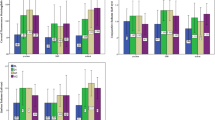Abstract
Purpose
Our purpose is to present the characteristics of newly developed diffusion filters that can reduce the best-corrected visual acuity (BCVA) of the non-amblyopic eye to a specified value and that can be used to treat amblyopia.
Methods
Silica sol is a colorless and transparent colloidal gel of different particle sizes. The silica was added to an emulsion adhesive, thoroughly mixed, and coated evenly on polyethylene terephthalate films. Twelve filters with 12 different concentrations of silica were constructed. The density of the silica particles on the films was determined by scanning electron microscopy, and the haze values and light transmittance were measured with a goniophotometer. The reduction of the BCVA by the filters was determined in 16 healthy young women (mean age, 22.0 ± 2.3 years) by attaching the filters to spectacles.
Results
Scanning electron microscopy showed a monolayer of evenly spaced silica particles. The haze values of the 12 filters were related to the concentration of silica. The total light transmittance of the 12 filters was not significantly correlated to the concentration of silica. The BCVAs measured with the 12 filters were significantly and inversely correlated with the concentration of silica for both eyes (right eye, y = 0.174x - 0.197, R2 = 0.951; left eye, y = 0.173x - 0.212, R2 = 0.983).
Conclusions
These findings indicate that these diffusion filters can reduce the BCVA with no reduction of light transmittance. We conclude that they can be used to degrade the image of the dominant eye by known amounts in patients with amblyopia without affecting the overall light levels to the eye, i.e., form deprivation without light deprivation.






Similar content being viewed by others
References
Holmes JM, Clarke MP (2006) Amblyopia. Lancet 367:1343–1351. doi:10.1016/S0140-6736(06)68581-4
Agervi P, Kugelberg U, Kugelberg M, Simonsson G, Fornander M, Zetterstrom C (2009) Treatment of anisometropic amblyopia with spectacles or in combination with translucent Bangerter filters. Ophthalmology 116:1475–1480. doi:10.1016/j.ophtha.2009.02.023
Chen Z, Li J, Thompson B, Deng D, Yuan J, Chan L, Hess RF, Yu M (2015) The effect of Bangerter filters on binocular function in observers with amblyopia. Invest Ophthalmol Vis Sci 56:139–149. doi:10.1167/iovs.14-15224
Stewart CE, Moseley MJ, Stephens DA, Fielder AR (2004) Treatment dose–response in amblyopia therapy: the Monitored Occlusion Treatment of Amblyopia Study (MOTAS). Invest Ophthalmol Vis Sci 45:3048–3054. doi:10.1167/iovs.04-0250
Stewart CE, Stephens DA, Fielder AR, Moseley MJ, Cooperative R (2007) Objectively monitored patching regimens for treatment of amblyopia: randomised trial. BMJ 335:707. doi:10.1136/bmj.39301.460150.55
Wallace MP, Stewart CE, Moseley MJ, Stephens DA, Fielder AR, Monitored Occlusion Treatment Amblyopia Study C, Randomized Occlusion Treatment Amblyopia Study C (2013) Compliance with occlusion therapy for childhood amblyopia. Invest Ophthalmol Vis Sci 54:6158–6166. doi:10.1167/iovs.13-11861
Pediatric Eye Disease Investigator Group Writing C, Rutstein RP, Quinn GE, Lazar EL, Beck RW, Bonsall DJ, Cotter SA, Crouch ER, Holmes JM, Hoover DL, Leske DA, Lorenzana IJ, Repka MX, Suh DW (2010) A randomized trial comparing Bangerter filters and patching for the treatment of moderate amblyopia in children. Ophthalmology 117:998–1004. doi:10.1016/j.ophtha.2009.10.014, e1006
Odell NV, Leske DA, Hatt SR, Adams WE, Holmes JM (2008) The effect of Bangerter filters on optotype acuity, Vernier acuity, and contrast sensitivity. J AAPOS Off Publ Am Assoc Pediatr Ophthalmol Strabismus Am Assoc Pediatr Ophthalmol Strabismus 12:555–559. doi:10.1016/j.jaapos.2008.04.012
Pérez GM, Archer SM, Artal P (2010) Optical characterization of Bangerter foils. Invest Ophthalmol Vis Sci 51:609–613. doi:10.1167/iovs.09-3726
Iacobucci IL, Archer SM, Furr BA, Martonyi EJ, Del Monte MA (2001) Bangerter foils in the treatment of moderate amblyopia. Am Orthopt J 51:84–91. doi:10.3368/aoj.51.1.84
Mansouri B, Thompson B, Hess RF (2008) Measurement of suprathreshold binocular interactions in amblyopia. Vis Res 48:2775–2784. doi:10.1016/j.visres.2008.09.002
Baker DH, Meese TS, Mansouri B, Hess RF (2007) Binocular summation of contrast remains intact in strabismic amblyopia. Invest Ophthalmol Vis Sci 48:5332–5338. doi:10.1167/iovs.07-0194
Hess RF, Mansouri B, Thompson B (2010) A binocular approach to treating amblyopia: antisuppression therapy. Optom Vis Sci Off Publ Am Acad Optom 87:697–704. doi:10.1097/OPX.0b013e3181ea18e9
Hess RF, Mansouri B, Thompson B (2010) A new binocular approach to the treatment of amblyopia in adults well beyond the critical period of visual development. Restor Neurol Neurosci 28:793–802. doi:10.3233/RNN-2010-0550
Hess RF, Mansouri B, Thompson B (2011) Restoration of binocular vision in amblyopia. Strabismus 19:110–118. doi:10.3109/09273972.2011.600418
Li J, Thompson B, Deng D, Chan LY, Yu M, Hess RF (2013) Dichoptic training enables the adult amblyopic brain to learn. Curr Biol CB 23:R308–R309. doi:10.1016/j.cub.2013.01.059
Acknowledgments
We thank Professor T. Fujikado of Osaka University for critical comments on the manuscript.
Author information
Authors and Affiliations
Corresponding author
Ethics declarations
Funding
No funding was received for this research.
Conflict of interest
All authors certify that they have no affiliations with or involvement in any organization or entity with any financial interest (such as honoraria; educational grants; participation in speakers’ bureaus; membership, employment, consultancies, stock ownership, or other equity interest; and expert testimony or patent-licensing arrangements), or non-financial interest (such as personal or professional relationships, affiliations, knowledge or beliefs) in the subject matter or materials discussed in this manuscript.
Ethical approval
All procedures performed in studies involving human participants were in accordance with the ethical standards of the institutional and national research committee and with the 1964 Helsinki declaration and its later amendments or comparable ethical standards.
Informed consent
Informed consent was obtained from all individual participants included in the study.
Rights and permissions
About this article
Cite this article
Sasaki, M., Iwasaki, T., Kondo, H. et al. Properties of new diffusion filters for treatment of amblyopia with accurate occlusive effects. Graefes Arch Clin Exp Ophthalmol 254, 1181–1187 (2016). https://doi.org/10.1007/s00417-016-3334-x
Received:
Revised:
Accepted:
Published:
Issue Date:
DOI: https://doi.org/10.1007/s00417-016-3334-x




